Have you ever loved someone so impossible that they made you want to tear your hair out?
Have you ever known someone who seemed really complicated at the time, but when you really, really think back, you realize they were about simple as it gets – that just maybe you were the complicated one?
Have you known someone whose company turns minutes into hours, until you forget hunger in a the wake of good conversation?
Do you like to whittle? How about the opposite – slowly adding bits and bits to something until a whole forms?
You’ll experience all of the above with Flija. It’s a total workout – mind, body, and soul.
I’ll guide you through it.
Here’s the deal. Once in a while I make recipes on this blog that take a extra effort, like the twenty layer German Tree Cake (a family favorite). Other times, I make recipes that are incredibly simple but are designed to be as much an activity as they are a meal, like Hungarian Bacon on Sticks (genius). Today I bring you Flija, Kosovo’s blend of the two varieties – extra effort (it takes about 3 hours to make) and a social activity traditionally performed outside around a campfire. I’ve adapted the process for the broiler so you can make it without special equipment.
So what is flija?
Flija is traditionally a very plain large bread/cake slowly cooked outside near a campfire with loads of family and friends around.The campfire is used to heat a special lid covered in charcoal, which is actually what cooks the flija. I could go into a long complicated explanation, but the best thing for you to do is witness the wonderfulness here:
There seems to be two main approaches to Flija making – one uses a water/flour/salt batter, the other adds eggs and sometimes milk. Both versions are painstakingly layered like the rays of the sun, causing each layer to be cooked twice, browning and becoming delectable. In my experience, the egg batter has better flavor, although it seems most people just use the plain flour/water combo.
Here’s one description of a batter:
I need seven eggs and half a litre of milk for one batch. I let the batter rest for two hours after stirring well, to ensure that it is even. Meanwhile, I kindle a fire and start heating up the lid. I apply a coating of butterfat on the pan and then use a slightly larger spoon than normal to pour the batter. The first layer fills the entire pan, and then strips are added, and baked” – Fatima Mustafa.
A note for cooks:
I highly suggest mixing the batters the night before and then making the cake the next day, after the lumps have had time to disperse. Also, you’ll need a squeeze bottle or a empty plastic bottle, the lack of control from a batter bowl makes the project overly difficult. I got a squeeze bottle for 99 cents at the grocery store.
Anyway, I made this cake three times with three different techniques. I finally settled on the following recipe… proceed at your own risk!
Makes one 10″ Flija cake
Ingredients
Honey or jam, for serving
Batter 1
5 cups flour
5 eggs
2 tsp salt
3 1/4 – 3 3/4 cups milk
Batter 2
8 oz package sour cream (1 cup/227 g)
1 cup plain kefir
1 stick (113 g) butter, melted
Method:
Let’s amble through Kosovo for a little inspiration.
Ahhh, that’s better!
Now, mix up the two batters. In the first bowl, whisk together the egg batter. In the second bowl (a large measuring cup will do) whisk together the melted butter, sour cream and kefir (the oil pictured is to grease the pan).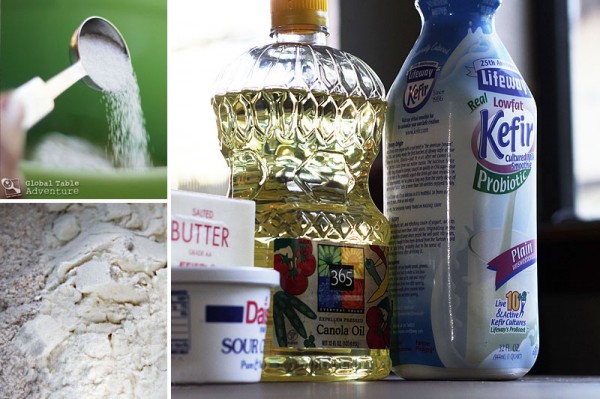
Mix both batters until they are lump free, setting aside at least an hour or overnight if possible.
Right before cooking, adjust the egg batter with flour or milk until it is somewhere between the thickness of crêpes and pancakes.
Turn on the broiler and oil a large springform pan.
Add one layer of egg batter. Brown under the broiler (this took 4 minutes for me, but could take as little as 2 minutes). Spread with a few spoonfuls of sour cream batter. Then, using the squeeze bottle, layer the batter around the pan like the rays of the sun. I found it easiest to work from the outside in, tapering off towards the center so I didn’t have too much batter in the middle.
Broil again. In fact, get used to the idea. That’s what you’ll be doing for the next 2-3 hours.
I wish I could say I was joking.
Grab a glass of wine and a girlfriend. Let the chitter chatter begin. That’s the fun of it!
Now, once the spokes have cooked, brush with more dairy mixture and then squeeze on some more batter between the most recent spokes. (The batter should be thicker than this – but I wanted you to see the process).
Repeat process, broiling after every dairy and flour batter addition.
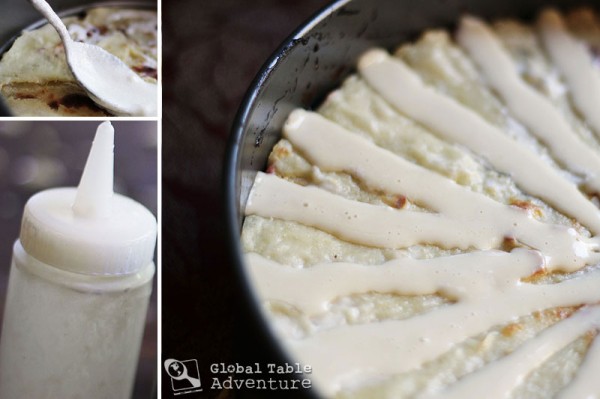
Eventually the pan fills up.. little by little. See how the spokes get browned because each one gets cooked twice…
Gorgeous! When you’ve used up all the batters, you’re done… slice it up. Take a big bite. Eat while hot! Immediately – do not delay…
As for the honey? Go for it! Drizzle it on. You’ll be smiling in no time…
… especially once you find a cozy spot to eat in Kosovo. What will you choose?
I just can’t..
… help myself once the…
Could you?
- 5 cups all-purpose flour
- 5 eggs
- 2 tsp salt
- 3 1/4-3 3/4 cups milk
- 8 ounces sour cream
- 1 cup kefir (plain)
- 1 stick butter , melted
- Whisk together each batter in its own bowl until they are lump free. Set aside at least an hour or overnight if possible.
- Right before cooking, adjust the egg batter with flour or milk until it is somewhere between the thickness of crêpes and pancakes.
- Turn on the broiler and oil a large springform pan.
- Add one layer of egg batter. Brown under the broiler for about 2-4 minutes.
- Spread with a few spoonfuls of sour cream batter. Then, using the squeeze bottle, layer the batter around the pan like the rays of the sun and broil again.
- Once the spokes have cooked, brush with more dairy mixture and then squeeze on some more batter between the most recent spokes.
- Repeat process, broiling after every dairy and flour batter addition.
- Eventually the pan fills up.. little by little.
- Drizzle honey when serving.
I highly suggest mixing the batters the night before and then making the cake the next day, after the lumps have had time to disperse. Also, you'll need a squeeze bottle or a empty plastic bottle, the lack of control from a batter bowl makes the project overly difficult. I got a squeeze bottle for 99 cents at the grocery store.


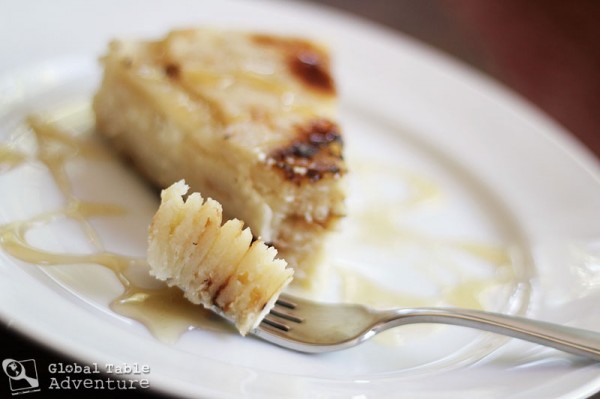
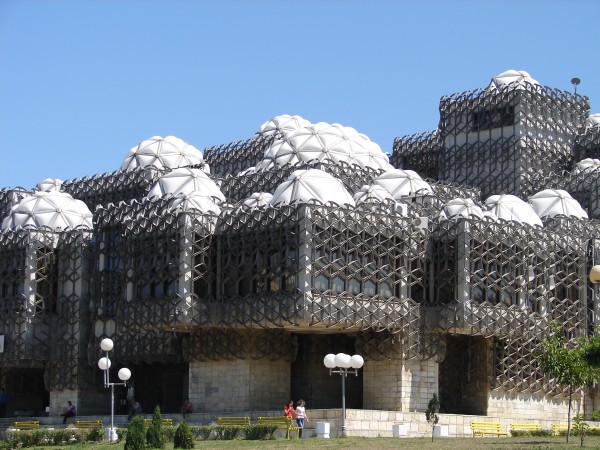

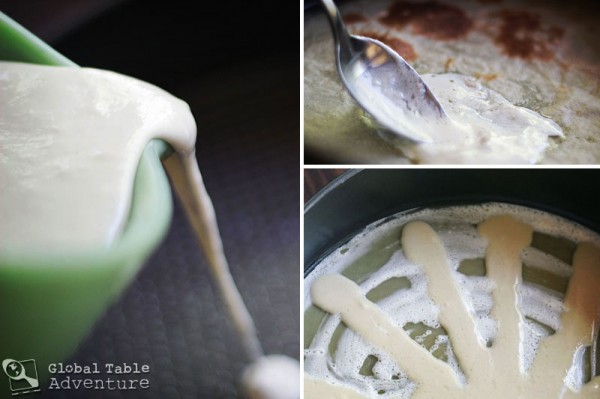
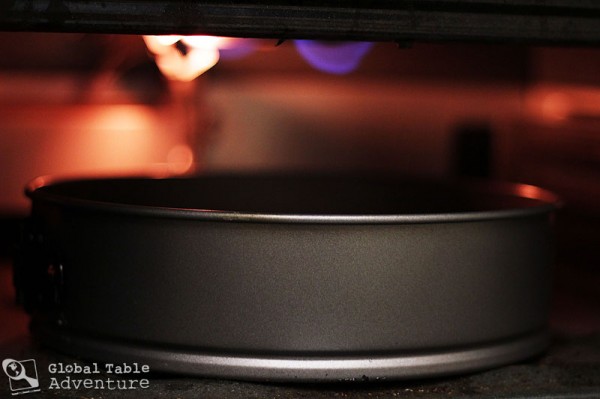
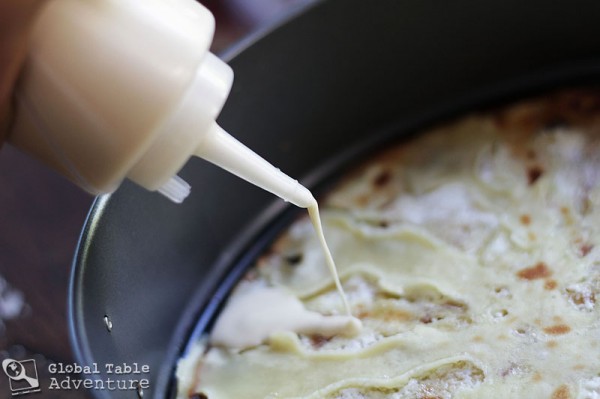
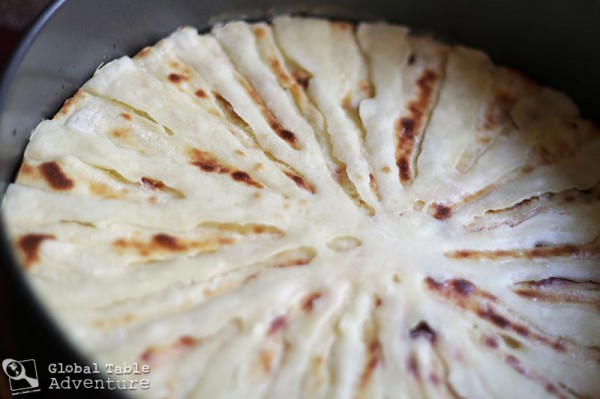
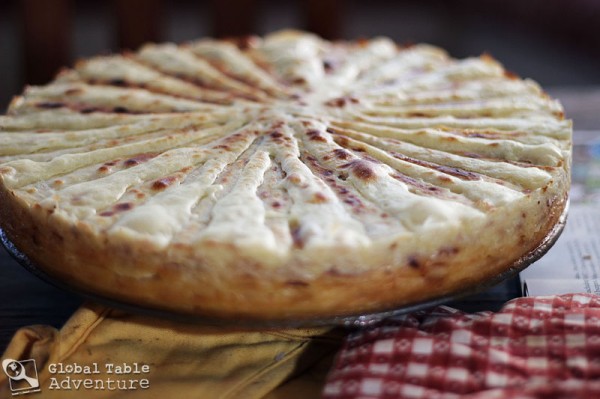





Pingback: 22 Campfire & Scandinavian Recipes to celebrate Midsummer’s Night
Pingback: 10 Essential tools & ingredients for cooking the world | Global Table Adventure